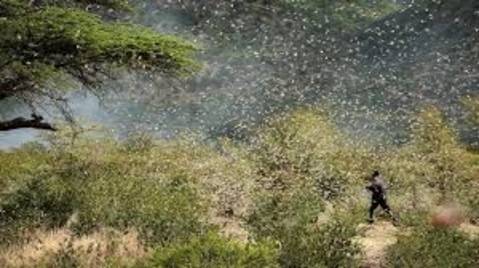A swarm of 40 million locusts eats the same amount of food in one day as about 35,000 humans, threatening the livelihoods of millions of people.
For much of this year, desert locusts have ravaged large swathes of farmlands and forage across East Africa, the Middle East, Southwest Asia and West Africa, in one of the worst outbreaks in decades, threatening the livelihoods of millions of people. And, thanks to climate change, scientists are warning that these outbreaks will only get worse in the future, as extreme weather events continue to break out across every region.
In November 2019, Djibouti suffered two years worth of rain in a single day. The water level of Lake Victoria, the largest lake in Africa, is the highest it has been in decades. Meanwhile, the Kilimanjaro region on the border between Kenya and Tanzania – which had consecutive, alternating wet and dry years – has just experienced the wettest year in four decades, all these creating the perfect conditions for the infestation.
Also year on year, the western part of the Indian Ocean is getting warmer relative to the eastern side – a phenomenon knows as the Indian Ocean Dipole (IOD) – creating both periods of long drought and heavy rainfall in East Africa.
“This is the heat from the emission of greenhouse gasses which is stored in the ocean and causes the ocean to warm up,” Abubakr Salih Babiker, a climate scientist with the Intergovernmental Authority on Development’s Climate Prediction and Applications Centre, told VICE News. “The Western part of the Indian ocean, the part that affects the East African region is seeing the fastest warming up of the tropical oceans in the past 100 years.”
The desert locust is the most destructive migratory pest in the world. They are part of a group of insects that have the ability to change their behaviour and migrate over large distances. You can have around 40 million to 80 million locust adults in each square kilometre of a swarm, travelling up to 150 kilometres a day. A swarm of 40 million locusts eats the same amount of food in one day as about 35,000 people.
The Sea Surface Temperatures (SST) in the Western Indian Ocean have increased by 1.2 degrees centigrade in the past century, higher than the global average of just slightly below 1 degree centigrade. At this rate, the locust invasions seen this year will become more common, bringing with them diseases and other pests, Babiker added. A positive IOD of warmer ocean water near the East African Coast will also result in higher annual rates of cyclones and more rainfall.
In 2019, there were a record-high eight cyclones in the Indian Ocean. Heavy rains caused by Cyclone Mekunu created desert lakes in Saudi Arabia’s “empty quarter” region. This is where the desert locusts lay their eggs and feed on the green vegetation. Consecutive cyclones that brought heavy rains to the Horn of Africa created conducive grounds for these locusts to then bread.
By April this year, over 500,000 hectares of cropland including sorghum and maize were damaged in Ethiopia, putting over a million people in need of food assistance. Pakistan declared a national emergency to combat the pests after locusts devoured wheat and cotton crops before crossing over to India, while Somalia declared a national emergency over their invasion.
The locusts have also caused havoc in Sudan, South Sudan, Djibouti and Eritrea, too. Uganda, Tanzania and the Democratic Republic of Congo have also reported problems in handling the swarm. Residents in Ethiopia, Somalia and Kenya have tried to fight the pests by lighting fires, banging plastic bottles, honking their cars and screaming, all in vain. The invasion is now expected to continue into October, as parts of Somalia, Sudan, Yemen have been hit by double the normal rainfall in August and September.
The UN’s Food and Agriculture Organisation says it needs $153 million to respond to the eight Eastern African countries affected this year, where 20.2 million people are already facing severe acute food insecurity.
f conditions become less favourable in East Africa, the pests will continue to migrate to the already food insecure Sahel region in search of green pastures. The last time the Sahel region was hit by a locust invasion was in 2003-05, which caused severe food shortages affecting more than 8 million people and destroying crops worth $2.5 billion.
In March 2020, there were an estimated 17.2 million food-insecure people in West Africa, a desert locust outbreak would expand that number considerably.
“The climate is oscillating between extremes of dryness and wetness and these kinds of extreme weather are expected to continue in the future,” Babiker said. “Information and knowledge are the power that can help avert the impact of these extreme events.”
Source: Vice






























